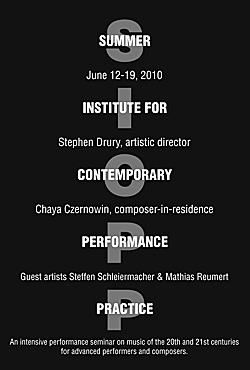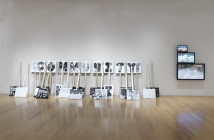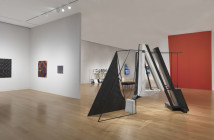By JOHN PYPER
The New England Conservatory and the Summer Institute for Contemporary Performance Practice (SICPP) demonstrated their commitment to new music by devoting an evening at Jordan Hall to 20th century German composers. Steffen Schleiermacher, a guest artist for SICPP, performed six solo piano works on Tuesday evening, June 15th. He started with his own composition Lîla(2003), a selection from Helmut Lachenmann's Ein Kinderspiel (1980), Nicolaus Richter de Vroe's Gabbro (1998), Friedrich Goldmann's Four Piano Pieces (1973), Karlheinz Stockhausen's Klavierstuck 1-4 (1952), and finished with Wolfgang Rihm'sNachstudie (1994).
The evening started with Lîla whose main characteristic is an electronically produced drone-- a hum emanating from the piano that permeates the entire performance. A floating meditation played more traditionally from the keyboard is woven through this drone, airy and drifting, like one of Alexander Calder's mobiles turning slowly above your head. This work is composed by the performer, and was the most languid of the works that evening. Its casual meditative grace was in stark contrast to the battering the piano took in other compositions that evening. Lîla was inspired by classical Indian sitar compositions (including the drone) and is certainly a dignified translation of those works.
The moment the piano rang out, the entire piano came to life with a purring vibration. It was alarming at first, trying to find the source of this buzzing. I did not expect this sound. Pianos don't naturally make this noise for an amateur like me, and this was the connecting fiber running throughout the concert. Each of the six compositions forced the performer to interact with the piano in unusual ways, sometimes through more than just the keyboard. Reaching in to hit the strings directly or holding open the piano's dampers on some strings to allow them to resonate sympathetically. This concert illuminated numerous possibilities available to both the composer and performer that have surfaced in the last century.
Ein Kinderspiel is a klanky percussive assault on the piano that imitates children's toys. It was jarring hearing it so soon after the soft moments produced by Schleiermacher's own composition. This composition is excessively percussive. In the final section, one note is repeatedly banged with the right hand and the resonance of the piano is opened with the left hand, creating a set of tones that again hum out of the piano. This piece is like nothing I have ever heard. It expands what I understand the piano to be capable of without modification. A prepared piano can make the most unreal sounds, imitating electronic noises and altering the timbre of the piano but I've never heard a traditional performance colored with these sounds.
Gabbro (Steinstück #1) is a solicitous and nuanced collection of patterns. They sound like obsessively repeating bird songs, with alterations and developments happening as the patterns change. Hostile beatings of the keys by the elbows peppered into this work really made me jump. This work brings out Schleiermacher's specialty: notes ringing out at full, and I mean full volume. The dynamics he is able to pull out of the piano were remarkable. His control in these loud passages, keeping the same attack, the same length of tone, matching these notes no matter how savage was spectacular. His playing produced distinct and firm results that permitted these intricate compositions a carnal weight.
Four Piano Pieces is a broad composition employing the full range of the piano, from soft and lyrical to fast and unexpected, these unresolved themes weave in and out and suddenly end without conclusion. This is an expansive piece of music with long silences. The silences construct a rather chunky and not a quiet composition. These moments of pause connect sections of music that are unresolved and unrelated that build up a tapestry of sounds. To speak of its visual relatives, it was composed like a Rauschenbergsilkscreen. A little of this, a memory of that. Some news of the day. Distinct, broken moments situated next to each other, fashioned as a single work.
Klavierstuck 1-4 was Stockhausen's first work in a new system called group composition. The relationships are mathematically based rather than flowing tonal proportions. It is related through a range or scales by a numerical code. Very clean and nuanced, but very hard to follow.
Nachstudie was the longest performance of the evening by far. It also was the most psychologically emotive. At the beginning, it is very sparse, single notes drifting through the hall. This composition builds organically, like the performer is improvising with open and random sounds, yet soon enough they link together into a distracted feeling of anger, eventually softening and becoming less tense. Throughout are unexpected protrusions of sound, hard edged, jutting out of the irritated composition. It ends in a contemplative mode through slow changes, still spiked with phrases extending out of the increasingly elated music.
SICPP and Schleiermacher provided a great concert at a great venue. The utilitarian music, somewhat alien when heard in a room with golden cherubs glowing against rich wood grains, challenged the listeners with what was possible rather than what was conventional.
The New England Conservatory
Summer Institute for Contemporary Performance Practice (SICPP)
"The Summer Institute for Contemporary Performance Practice" is on view June 12 - 19, 2010 at The New England Conservatory.




